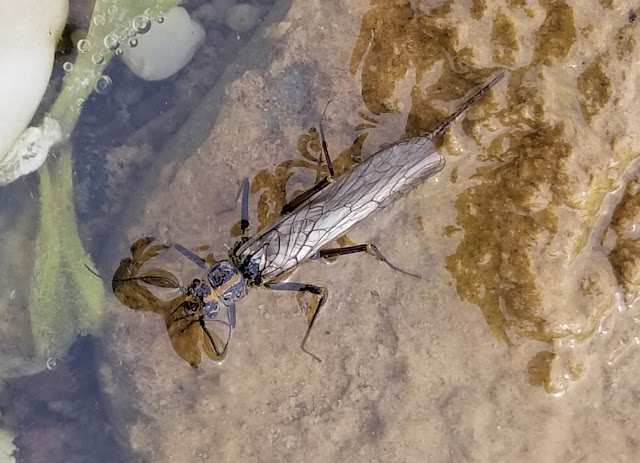When I see the Pipevine Swallowtail butterfly working the wildflowers
of the Yuba River, it’s for certain that spring is here. The weather though has
been much colder lately with a few decent shots of precipitation and low snow
fall. The first storm on the 10th provided 8 inches of fresh pow
here at my house north of Nevada City, and the last storm on Sunday night gave
us 4 inches of snow. After such a light winter, we’ll take it. Thursday’s storm
could be a good one, with another weak system possible Monday followed by an
extended dry spell. As always, if you really want to geek out on the upcoming
weather go here: https://opensnow.com/dailysnow/tahoe
Deer creek came up slightly on both storms but did not dirty up the Yuba River, in fact it was very beneficial as it added a slight tint to the upper river keeping those trout and steelhead less spooky. Currently, the flows on the Yuba River at Parks Bar Bridge are flowing at 795 cubes with Deer Creek slowly dropping.
Fishing has been decent with the really good days mixed in with the slower days. When you’re on the river 5 days a week, you notice how different everyday can be, and often there seems to be no rhyme or reason to it – It’s the Yuba lol. It is advantageous though, as you can really get in tune with the hatches and the daily behavior of the trout and steelhead. My guests and I are still long line Euro nymphing in the mornings, and then switching to dry flies through the afternoon. Yup, the same old game plan for the last 3 months. On the nymphing rig, the Skwala stone anchor fly is receiving the most love from the fish, and for the tag fly it’s all about the shot glass baetis – anything baetis really.
This past winter season I’ve switched to using a standard 9
foot tapered leader for my guests when they are fishing dry flies, and it
really makes a difference with those that have less skill. They hit their
marks better with a shorter leader, and as long as you are using a fly first presentation,
or fishing rough or blurry water that can mask your mistakes, fly line, or
leader while making the traditional upstream approach, you will find success. A
longer leader helps though on the glassy flats, and I use a leader formula
taught to me by legendary guide Dale Dennis on the Fall River in the late 90’s.
The original Fall River formula starts with 5 feet of 40lb. hard mono, then
using a blood knot attaching a 9 foot tapered leader to 6x, then adding 36” of 7x
tippet with a triple surgeons knot. For the Yuba or other waters, I go with 3
feet of the 40lb. and then adding a 9 foot tapered leader to 4x (skwalas,
goldens, hoppers, etc.) or 5x (mayflies, midge clusters, etc.). I even use the
latter leader formula for fishing stillwaters like Lake Davis with a floating
line for the shallow shoals.
Let’s talk bugs. I’ve said this before, but I’m consistently
learning something new with the aquatics. The Brown Dun (Ameletus) I’ve been reporting about the last 3 months has a new
twist to it. For the past few weeks I’m noticing a tad smaller version of it,
which would point to maybe another brood, and adding to more confusion of the Brown
Dun being a March Brown. Does it matter? I think with some fish it will, being
that both mayflies have their own unique size and color. The other difference
is that the March Brown is much more available to the trout because the nymph
to dun emergence is mid-stream, whereas the Brown Dun hatches on the shoreline and
must be blown into the water to be consumed by a fish.
Pinky mayflies (Epeorus)
have been the most dominant mayfly, and there are two sizes hatching in both a
14 and a 16. I’m noticing less PMDs, but they are still out there. The Comparadun, a simple guide tie, can cross over for both bugs and crushes. Lastly, seeing
more BWOs and they are much bigger than previously reported in a size 16. One
thing I’ve noticed on the Yuba is using a slightly smaller pattern than the
natural will most often make a big difference in getting the grab. With a
little more rain in the forecast, we should see increased mayfly activity and
better dry fly fishing. Looking forward to it!
See you on the water…









No comments:
Post a Comment